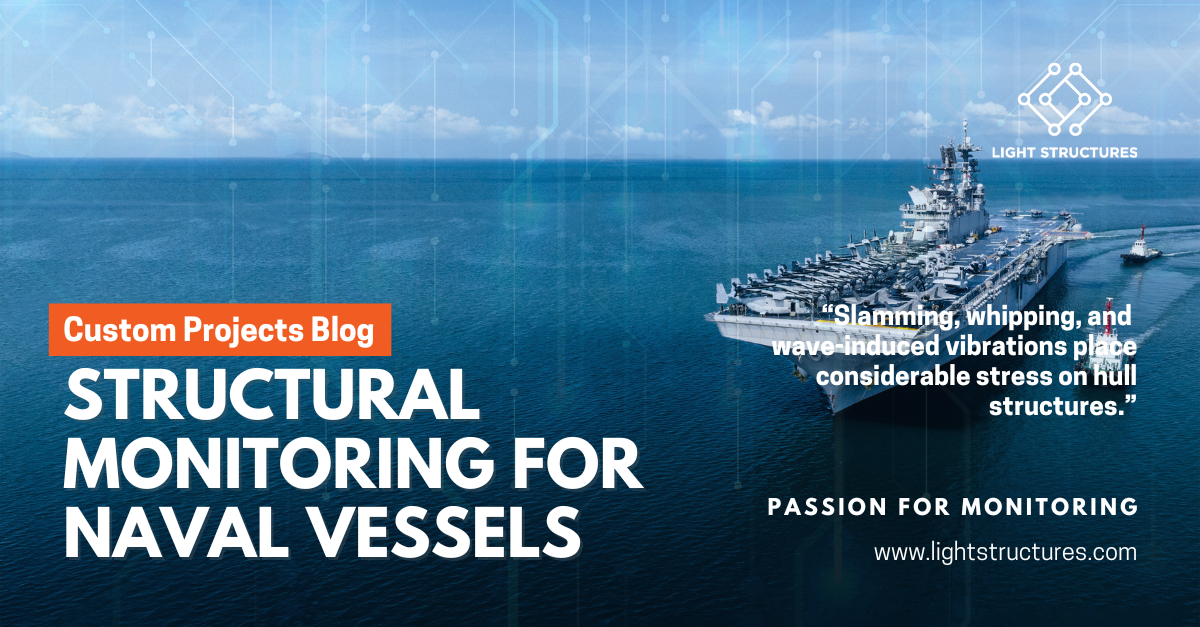Custom Projects: Structural Health Monitoring for Naval and Coast Guard Vessels

According to Structural Health Management in the Navy, naval vessels are designed so that if properly maintained, their structures should not experience structural damage – defined as crack initiation – during their design life. But achieving this goal requires more than routine inspection. In increasingly demanding maritime environments, advanced Structural Health Monitoring (SHM) systems are becoming essential to ensure mission readiness, reduce lifecycle costs, and enable safer operations across a diverse range of naval, and coast guard vessels.
Light Structures has long worked with navies and defence agencies worldwide to develop tailored SHM solutions based on the SENSFIB™ technology platform. Whether for high-speed corvettes, complex semi-submersibles, or coastal patrol vessels, these custom projects deliver actionable insights that enable smarter operational decisions and reduce unplanned maintenance.
Structural integrity under pressure
Modern naval vessels are frequently deployed in open seas under severe wave and weather conditions, often at high speeds and in semi-displacement mode. In these environments, slamming, whipping, and wave-induced vibrations place considerable stress on hull structures. Over time, this can lead to fatigue, especially in lightweight materials or complex hull forms.
Light Structures’ SENSFIB Navy™, SENSFIB Ice™ and SENSFIB Global Forces™ systems are proven tools for proactively managing these challenges. Installed on vessels from the Royal Norwegian Navy’ Skjold Class corvettes to U.S. Military Sealift Command platforms, these systems measure and monitor key stress points using fibre optic sensors that require no recalibration, are immune to electromagnetic interference, and offer exceptional long-term accuracy.
By presenting live data in an intuitive onboard advisory format – often as a simple go/no-go signal – SENSFIB systems empower navy and coast guard crews to operate safely within structural limits, while onshore teams can perform detailed post-mission analysis to guide fleet-level maintenance strategies.
Supporting lifecycle maintenance strategies
One of the greatest advantages of SHM in naval contexts is the ability to shift from time-based to condition-based maintenance. This shift offers significant benefits: reduced drydocking, fewer emergency repairs, longer asset lifespans, and more predictable deployments, and budgeting. Data collected over time can even influence future vessel designs by identifying structural behaviours that exceed modelled expectations.
Light Structures’ installations support this approach by delivering dependable structural data that enables lifetime management of key hull areas. For example, through real-time fatigue accumulation tracking and maximum load statistics, decision-makers can rotate assets or adjust mission profiles to extend vessel longevity.
Purpose-built monitoring for coast guard operations
While SHM is often associated with larger naval platforms or commercial ships, the lifecycle management and operational safety of smaller, high-speed vessels like coast guard patrol boats can also be optimised with dependable data. Light Structures has developed tailored SENSFIB solutions for these types of assets, helping operators avoid the long-term costs of structural damage that can result from repeated stress exposure.
SENSFIB Navy is installed on a wide range of fast vessels including several United States Coast Guard Sentinel-class Fast Response Cutters. These 154-foot craft are designed to patrol coastal regions, so face a variety of conditions, many of which can impact the integrity of the hull. The precision data provided by SENSFIB Navy means that any issues can be addressed before they develop into a more hazardous and costly safety issue.
Driving future capability through European collaboration
Light Structures’ commitment to innovation in naval SHM is further demonstrated through participation in European Defence Fund (EDF) sponsored R&D programmes. dTHOR (Digital Ship Structural Health Monitoring), led by SINTEF, aims to redefine how SHM data is interpreted in naval applications. By combining advanced sensors, open-standard digital frameworks, and hybrid physics-data models, dTHOR will pave the way for predictive monitoring that enhances both safety and efficiency.
The second, EDINAF (European Digital Naval Foundation), led by Navantia, will define a reference architecture for digital naval ships, integrating systems onboard to elevate operational capabilities. Light Structures’ role in this project focuses on advancing the digitalisation of SENSFIB SHM data and aligning with emerging European standards for maritime digital systems.
Custom SHM, ready for deployment
As in the commercial sector, there is no one-size-fits-all approach to structural monitoring in the naval domain. From lightweight corvettes operating at speed to patrol vessels performing repetitive, high-load manoeuvres in coastal seas, every asset has unique structural requirements.
Light Structures supports this diversity by providing a custom projects approach based on our advanced, field proven SENSFIB sensor platform. Whether installed during building or retrofitted as part of a mid-life upgrade, these systems provide long-term value through safer operations, reduced maintenance, and improved fleet performance. With SHM fast becoming a strategic enabler of future naval capability, Light Structures’ custom projects are helping defence and security organisations stay ahead – structurally and operationally.
